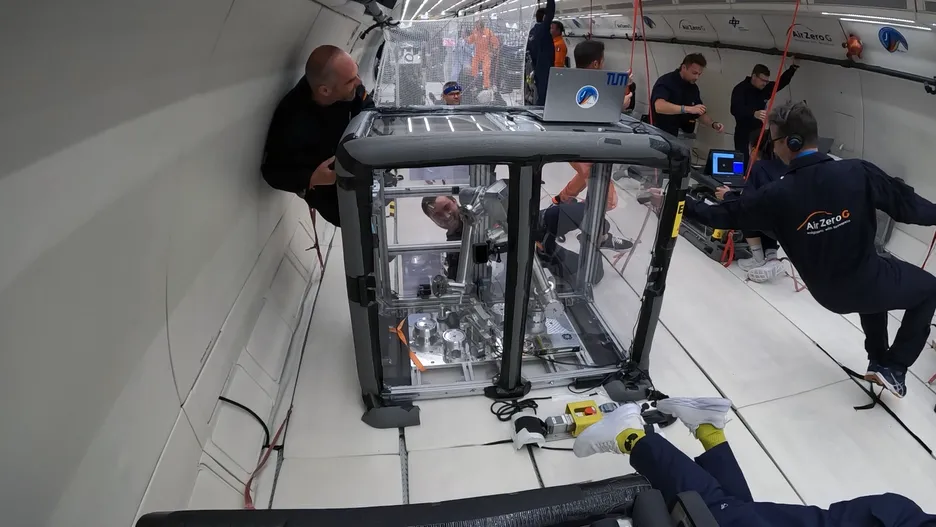Collaborative robot algorithms in weightlessness evaluated
Research |
In the video: 42nd DLR parabolic flight with experiment from TUM
The RoboGrav mission conducted by KINETIK Space, the German Aerospace Center (DLR) and the Technical University of Munich (TUM) aimed at testing a fully torque-sensorized robotic arm equipped with collaborative control algorithms developed at TUM under microgravity conditions. Based on the lightweight robot technology developed by DLR, this robotic arm is designed to perform in-orbit assembly and servicing tasks. The torque sensors of the arm allow the use of an impedance control law, enabling safe interactions with the environment. This control law computes the joint torques proportional to the position error. By specifying a desired stiffness profile which is used as proportional factor, forces exerted on the environment can be controlled and limited to safe values, a key ingredient for space robotics.
As full automation in complex assembly or maintenance scenarios is unrealistic and as a fallback mechanism for human intervention is required, TUM researches algorithms supporting a human operator when remotely controlling a robot as part of the ACOR project. Virtual fixtures are used to render haptic feedback to a human operator, providing guidance to successfully complete a task via virtual force fields. Classic implementations can for example simulate virtual walls that produce a repulsive force when penetrated. The probabilistic multi-modal formulation developed by TUM takes multiple input sources into account to always select the optimal fixture.
Within the ACOR project, those algorithms were already tested on Earth in the use case of CubeSat subsystem assembly. The RoboGrav mission now offered the possibility to also evaluate the technology under 0g conditions, bringing it a lot closer to a real space application. It was also used to extend the algorithms to model transitions between human-lead manipulation and full automation.
Approaching space conditions with a parabolic flight
Parabolic flights with the Airbus A310 Zero-G offer a 0g-phase (± 0.02 g) for approximately 22 seconds, framed by a phase of hypergravity (1.8g) before and after the microgravity phase. This microgravity phase can be used to approximate conditions in space where no gravitational forces are acting. This makes it possible to test the behavior of robot control algorithms both under normal gravity and zero gravity, which is important for the development of space applications. Similar and predictable behavior under both conditions allows to transfer algorithms developed and tested on Earth with confidence to space applications.
The video shows the phases of one parabola conducted during the 42nd DLR parabolic flight. In total, 94 such parabolas were conducted, allowing for a total experimental time of around 34 minutes. The scene from a small free-floating area that could be used by experimenters during some of the parabolas shows that during the microgravity phase, free floating, as e. g. known from astronauts aboard the ISS is possible. This microgravity environment is also used to train and prepare astronauts for space missions.
For the experiment, which was always supervised by at least one operator to make use of all parabolas, at the start of the microgravity phase, this operator pushes the deadman switch to release the robot’s brakes and start the experiment. The video shows a part of the experiment with human interaction where a second operator pulls on a string simulating a remote haptic input device, therefore interacting with the Virtual Fixtures. The experiments could be concluded with nominal behavior both of the robot and of the collaborative control algorithms developed by TUM, bringing the application of torque-sensitive robots equipped with advanced control algorithms in space a lot closer.
